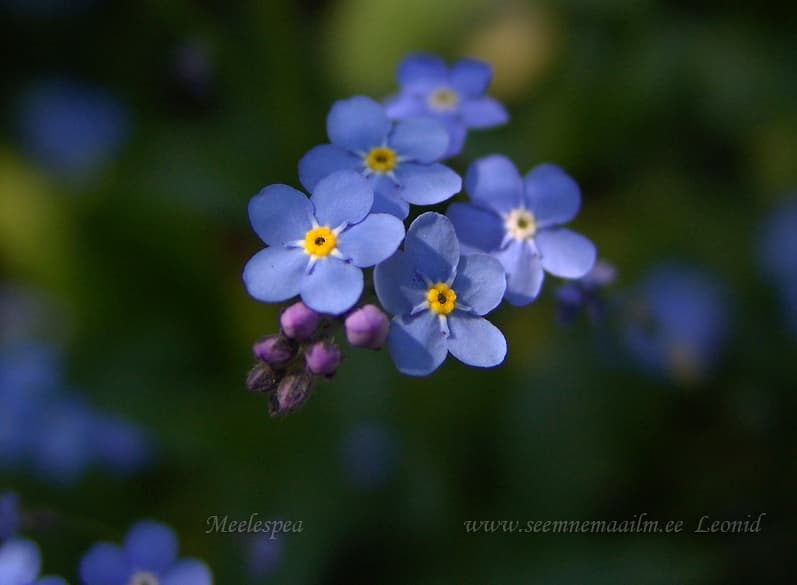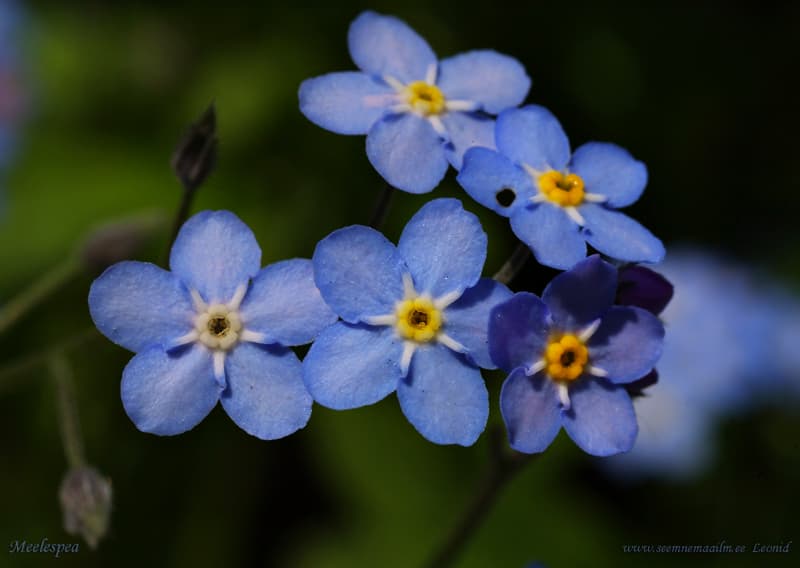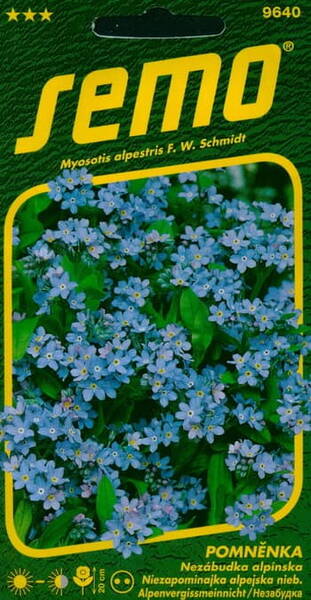A beautiful early spring garden plant, forming a compact 20-25 cm tall bush with bright dark blue flowers gathered in small, loose, short, cylindrical inflorescences. Diameter: 1-2 cm.
Prefers loamy soils and is moisture-loving. For best growth, plant in semi-shaded areas on moist, fertile soil.
Indispensable for spring garden decoration, especially decorative in combination with lacfiola, used for decorating balconies, flower beds, flower gardens, forcing and for cutting.
Blooms in the 2nd year.
The plants are winter-hardy and tolerate transplanting well during spring and summer while in bloom. They bloom profusely for 40-45 days.
They look magnificent not only in a flowerbed but also in a pot or balcony box. On a balcony or terrace, forget-me-nots look great in combination with other biennials.
Agricultural technology.
Sowing: in May-June in seedbeds in a greenhouse. Propagation by seed only.
Lightly dust the seeds with light soil and firm them with a board. Transplant after four weeks, when the plants have two true leaves, to a distance of 5 cm. In August, when the plants reach a height of 4-5 cm, transplant them to their permanent location. Space them 15-20 cm apart. After transplanting, water the plants well. They prefer semi-shaded areas and moist, fertile soil. Sow seedlings in October-November for flowering plants in the spring.
Care : watering, fertilizing at intervals of 3-4 weeks.
Flowering : from May, for 40-45 days.

Alpine forget-me-not - Myosotis alpestris FW Schmidt.
It grows on rocks in the alpine belt of the Alps, Carpathians, and Caucasus.
This perennial has a short rhizome and a dense rosette of grayish, hairy basal leaves. The low (5-15 cm), dense bushes are covered with masses of flowers in spring. The flowers are dark blue, in fairly short inflorescences. It blooms profusely in May for 40-45 days. Unlike other forget-me-nots, this plant loves the sun, typically found in rocky habitats. It reproduces only by seed. Numerous garden cultivars have been developed from this forget-me-not. True alpine forget-me-nots are rarely found in cultivation.
Soil: Grows well in areas with moist, fertile soil. Overly rich soil, especially if fertilized with fresh manure, causes vigorous, prolonged leaf growth, which disrupts the natural rhythm of seasonal growth and development characteristic of these species.

Alpine garden forget-me-not. Bot. syn.: Myosotis sylvatica Hoffm. subsp. alpestris (FWSchmidt).
* Alpine garden forget-me-not .
A perennial plant cultivated as a biennial, the garden forget-me-not is a very undemanding plant. It grows well and blooms profusely in both sun and shade, but prefers partial shade.
It blooms in the second half of spring, which in Estonia is mid-May. It tolerates spring drought and even frosts down to -5°C.
It blooms profusely for a long time (30-40 days). Numerous seeds ripen in late June and early July. The seeds fall, and seedlings emerge in July, forming dense, attractive bushes by August.
Location: They grow best in shade and partial shade. While forget-me-nots can also thrive in sunny areas, their flowering period is reduced from 30-40 days to 20 days. The exception is the alpine forget-me-not, which requires more sun.
Soil: Grows well in areas with moist, fertile soil. Overly rich soil, especially if fertilized with fresh manure, causes vigorous, prolonged leaf growth, which disrupts the natural rhythm of seasonal growth and development characteristic of these species.
Propagation: All forget-me-nots reproduce well by seed, which is sown in May-June in cold frames or test beds. They are planted in their permanent location in late August or the following spring. They self-seed abundantly.
Forget-me-not cultivars are propagated by cuttings. In May and June, cuttings are taken from the tips of growing shoots, 4-5 cm long, which are planted in raised beds and kept in shade.
Forget-me-not, which has a superficial fibrous root system, tolerates transplantation well throughout the season, even in full bloom.
If you purchased forget-me-not seeds in the fall and want flowering plants in the spring, sow them in October-November. Fill a box, pot, or milk carton with soil (make sure to poke a hole in the bottom). The soil should be light (two-thirds turf soil and one-third river sand). Before sowing, water it with a pink solution of potassium permanganate. Sow the seeds at the appropriate time according to the lunar calendar.
Forget-me-not seeds are sown randomly over the soil surface. It's important not to bury the seeds too deep, as they germinate faster in the light. Before sowing, soak the seeds in slightly salted water, discarding any that float to the surface. The seeds that sink to the bottom are sprinkled with clean water, allowed to dry slightly, and sown over the moistened soil surface. Lightly dust the seeds with light soil and compact them with a board. The surface should be level enough to prevent water from running off during watering. Until the first shoots appear (after 4-6 days), cover the soil with paper, over which water is applied. Once the seedlings have developed one or two true leaves, they can begin transplanting.
Forget-me-nots are transplanted into boxes or pots filled with moist peat soil, spaced 3-4 cm apart. The boxes are placed in a cold greenhouse to allow the plants to undergo the necessary cold period, but in March, they are moved to a warmer room.
Since forget-me-nots are shade-tolerant plants, their seedlings don't require additional artificial lighting even on cloudy days. However, it's important to maintain adequate soil moisture at all times. In late April, often already with buds, forget-me-nots can be planted in flower beds, where they will bloom in May. After flowering, there's a short period (June and July) when forget-me-nots lose their decorative appeal, as the plant dies completely, and the new shoots that emerge from the fallen seeds have not yet acquired their decorative appearance.
Each gardener decides for themselves whether to rely on forget-me-not self-seeding.
If the seeds are left on the plant until they disperse, the seedlings often appear all over the garden, cluttering other areas. Furthermore, faded forget-me-nots are a very unattractive sight. It's probably best to leave two or three plants until the seeds ripen, and then sow the freshly harvested seeds in the area reserved for forget-me-nots. The remaining plants should be removed from the flowerbed after flowering.
Due to the fact that forget-me-nots are planted quite densely and in the shade, their plantings practically do not require weeding.
Diseases and pests: Alpine garden forget-me-not in too wet and rich soils can be damaged by powdery mildew in the spring.
Use: indispensable for early spring decoration of flower beds and balconies, beautiful in large groups near water.
Marsh forget-me-nots can grow vigorously and root in moist, shallow soil. Alpine garden forget-me-nots are indispensable in flower beds where the selection changes throughout the season. Forget-me-nots, along with tulips and daffodils, are the most common spring flower arrangements in many European countries.
Forget-me-nots look great in borders and are also used in rock gardens. Just be careful not to let them grow too large, crowding out their neighbors.
Forget-me-not thickets look beautiful next to lily-of-the-valley, under the tree canopy. At the end of May, these are the most beautiful, stunning spots in your garden. These spring flowerbeds don't require much effort, as both lily-of-the-valley and forget-me-not form a dense ground cover that prevents weed growth. They bloom almost simultaneously, and after flowering, the flowerbeds can be decorated with taller, shade-tolerant shrubs planted nearby. (These include ferns: lady's foot, male fern, avolzhanka, Kamchatka meadowsweet, hosta, and others, scattered against a backdrop of low-growing forget-me-nots and lily-of-the-valley.)
Forget-me-nots look stunning not only in a flowerbed, but also in a pot or balcony box. Their delicate flowers are most beautiful when planted in abundance.
Forget-me-nots look great on a balcony or terrace when combined with other plants. They are also used as cut flowers, although it's best to use the entire bush for a bouquet rather than individual shoots. Simply wash the roots to remove any soil.
Placed in water in a beautiful ceramic vase, a forget-me-not bush will decorate your home for almost two weeks.
Partners: biennials with matching and contrasting colors. For example: dark blue violets, pale blue forget-me-nots, and bright yellow lilac-colored lilac.
Alpine Forget-Me-Not "Blue" - Myosotis alpestris.
Alpine Forget-Me-Not. Bot. syn.: Myosotis sylvatica Hoffm. subsp. alpestris (F.W.Schmidt).












